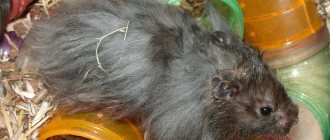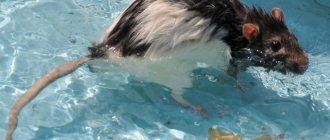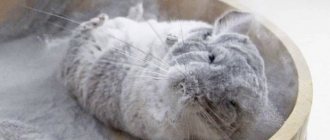Is it possible to walk a hamster outside?
You can let your rodent out for a walk, but take precautions. Only an adult animal that is not afraid of unusual conditions is allowed to be taken outside. It is advisable to let your pet walk in a wide and open space: a lawn, a flower garden, or the courtyard of a private house. The hamster needs to be given the opportunity to run around and stretch its legs. But the owner must carefully monitor the small rodent, making sure that it does not hurt itself, cut itself, get lost, or run away. You literally cannot take your eyes off the hamster: as soon as the owner gapes, the nimble baby disappears.
Is a walk necessary?
Your pet hamster should be given the opportunity to lead an active lifestyle. A large cage and ball will help increase physical activity. Jogging around the room or going outside will be beneficial.
Hamsters are naturally curious, but they experience discomfort when their environment changes. Veterinarians recommend regularly letting them out of the cage, letting them run and frolic in nature, but you need to monitor their safety.
A hamster is a small rodent; by nature it is not inclined to become attached to a person and will not come running when called. Therefore, it is worth limiting the area for walking, he will simply run away. Veterinarians say that you can walk your hamster everywhere, you just have to follow a few recommendations and rules.
How to properly organize walking a hamster?
How to walk a hamster in the fresh air so that it doesn’t run away, get into trouble, or get injured? If your pet is walking around the front garden, garden or private yard, then you need to make sure that he does not find a loophole in the fence or get out onto a pedestrian street or highway. When releasing an animal from your hands onto the ground, you need to make sure that there are no dogs, cats, rats, crows or other dangerous predators nearby. A hamster is a completely weak and defenseless creature; for predatory animals and birds it can become an easy and tasty prey. Items containing toxic substances and heavy metals should also be removed from the walking area. Painted and varnished wooden products are especially dangerous for your pet. The animal can chew them and get poisoned.
Communication
Hamsters are far from the most sociable rodents, since in nature they live strictly alone. At home, keeping a hamster should also be solitary; if there are several animals, then there should be several cages. Such a pet also does not strive to communicate with the owner, so you will have to spend a lot of time taming an independent rodent.
There are certain rules of communication; if they are not followed, the hamster will show fear and aggression, irritating the owner. In the first days after purchasing the animal, it is better not to disturb it at all, no matter how much you want to cuddle the fluffy little ball. It will take about a week to get used to the new home, and at the same time to the voice and smell of the owner. At this stage, it is recommended to say your pet's name while feeding .
Domestic hamsters differ little in temperament from their wild counterparts; they must be patiently trained to be handled so that communication brings joy to both the owner and the pet. With hamsters, the main remedy is food reinforcement - you need to teach the baby to take a treat from the palm of your hand. Gradually the rodent will get used to the hand, then it can be pulled out of the cage. Handle the animal with care - the tiny animal can be injured if it jumps out of your hands or is held too tightly. The safest thing to do is to wrap your palms around it, forming a “house”.
Contraindicated:
- wake up the animal;
- take from above, from the back (association with a predator attack);
- make sudden movements (even if bitten, you need to remain calm).
Caring for your hamster should include daily interaction. If you do not pick up your pet for a long time, a “rollback” will occur, and taming will have to start again. Contact should occur when the animal is active (in the evening).
What plants are dangerous for a hamster?
The owner must carefully ensure that a pet walking in the garden, flower garden or lawn does not inadvertently feast on a poisonous plant. On lawns and front gardens you can find quite a lot of herbaceous and flowering plants that can seriously poison or even kill a small animal. When releasing a rodent into a flower bed or garden, you must first make sure that the following ornamental plants do not grow there:
- hydrangea;
- rhododendron;
- yucca;
- yew;
- caladium;
- oleander;
- black nightshade;
- bean;
- autumn colchicum;
- mountain laurel;
- belladonna.
If the owner thinks that the hamster has tried any of the above plants, then the animal must be immediately taken to the veterinarian. Some garden plants are so poisonous that they can kill a small animal in a matter of minutes. When releasing a rodent into a clearing, lawn, lawn, you need to make sure that the baby does not eat the following wild herbaceous plants:
- lily of the valley;
- whistler;
- celandine;
- buttercup;
- raven eye;
- marigold;
- henbane;
- anemone;
- field poppy;
- hellebore;
- sleep-grass;
- wolf's bast;
- wild rosemary;
- digitalis;
- fern;
- dog parsley;
- Datura-herb;
- sow thistle;
- root fighter.
At home
Before letting your hamster run around the house, you need to remove all sharp and small objects, hide or raise all wires so that the animal does not chew them.
Hamsters have small feet but sharp claws. They calmly climb upholstered furniture and curtains. Make sure your hamster doesn't fall.
You can't leave your hamster alone - he might get stepped on.
You can walk at any time of the day, several times a day, using special devices.
Is it possible to put a hamster in a walking ball?
Pet stores sell special walking balls for rodents with small holes for air. Many owners buy these products for their pets to safely walk outside. Using the ball is simple: the lid opens, a hamster is allowed into the hole, the lid closes, and the animal runs around inside the ball to its heart's content. But it should be borne in mind that walking balls are not intended for small hamsters, but for larger rats. A small animal inside the product may feel uncomfortable and have great difficulty moving. The balls are comfortable, ensure a safe walk, but still limit the freedom of the animal.
Types of leashes
Leashes can be varied:
- leash with collar;
- harness;
- harness-vest;
- walking ball.
A leash with a collar is used for such pets extremely rarely, in cases where the hamster is a large breed. Most often, a hamster collar is used only for decorative purposes (collars with rhinestones, tiny collars with beads, etc. are worn). Taking a hamster for a walk wearing a collar is unreliable; the animal may wriggle out.
hamster leash
A harness is a more reliable option and is recommended for walks. A harness is a piece of equipment that is made of leather and fabric materials and passes through the chest and paws. The simplest type of harness is two small loops connected on the stomach, into which the hamster’s legs are threaded. The clasp and leash are attached to the back of the animal. Getting out of a harness is much more difficult than getting out of a collar.
hamster harness
The harness should be put on so that your little finger fits between the animal’s body and the harness. If you put on such a collar more loosely, the hamster will easily free himself, but if you put it on more tightly, you can harm your pet.
A harness is a vest with a leash attached to the back. A vest harness is considered more reliable than a regular harness. The animal itself feels more comfortable in such a harness.
vest-harness for hamster
Carefully! Collars and harnesses must be securely attached to the leash, otherwise a small animal can simply be lost.
Walking ball - it does not apply to leashes, but this is another suggestion for those who want to walk their hamster.
Typically, this is a plastic ball with holes made for ventilation. Not many owners use such a ball for walking, but in the case of a Djungarian hamster or another dwarf hamster, this is the most convenient solution. If the pet is larger, then it is more convenient to walk on a harness, because the pet does not feel very comfortable in the ball, the space is limited, and there is simply no opportunity to run on the ground. walking ball for hamster
Poor nutrition
Before you get yourself a furry pet, you should definitely familiarize yourself with its diet. Some products are strictly prohibited for him. For example:
- cabbage - any variety;
- milk - in its raw form causes severe distress;
- garlic;
- onion;
- some fruits, especially those that are too sweet.
Incorrectly selected products can not only cause disruption to the hamster’s gastrointestinal tract, but also injure its delicate body.
Solid foods must be present - for example, carrots. The rodent will sharpen its sharp teeth on it. Otherwise, they can grow greatly and become a real problem for him.
MUST HAVE A BED
Adding toilet paper or blotting paper to your home will encourage your little pet to peck at the paper and create a warm bed for themselves. The only thing you should remember in this case is that the paper should not have a smell, as this is harmful to our hamster and can lead to his poisoning. Likewise, if you want to add a little warmth to your home, place sawdust on your pet's floor. Sawdust, in addition to the fact that it perfectly absorbs odors (mainly urine), is also a good thermal insulator, so your animal will be even warmer in your home.
A bed made of paper and sawdust is a very good option for a hamster to find warmth.
GIVE HIM MORE FOOD
During colder winter periods, it is recommended to give our pet more food, because by fattening the animal we will increase its fat layer, which will help it better protect itself from the cold in a natural way.
As a hamster gets fat, its body fat increases and helps protect itself.
Likewise, you should remember that if you notice that your pet has any problems or its behavior has changed, it is better to immediately contact your veterinarian to undergo a full examination and thus rule out that a cold has caused any problems.
Hamsters are very active animals. Hamster owners often ask questions about whether or not they can let their pet go outside for a walk and how to properly walk a hamster without a walking ball.
- Is a walk necessary?
- On the street
- At home
- Walking equipment
- Conclusion
How to properly walk a hamster
Keep a male and a female in the same cage if you do not plan to have babies
Some inexperienced owners buy a pair at once - a female and a male, believing that they will have much more fun together.
However, one should not rush to conclusions. If you put a boy and a girl in the same cage, then one day they will make you happy with offspring. And it will not be one or a couple of small animals, but at least a dozen at once.
If you are not ready to breed these rodents, then it is better to purchase one. Hamsters themselves are not social animals; they do well without company, in splendid isolation. And so that they don’t get bored, you can place various wheels, labyrinths and hammocks. Nowadays you can find a wide selection of products in the pet store.
Failure to study the main signs and symptoms of diseases
It is imperative to know the symptoms of certain diseases. After all, prevention is the best treatment. A timely visit to the veterinarian can save your pet and help avoid many problems.
It is worth paying attention to changes in the behavior of your furry pet. Reasons for concern may include:
- excessive activity and lack of sleep;
- lethargy;
- lack of appetite;
- sadness.
If you find this, be sure to contact a specialist.
CAB HEATING TRICKS
- Towel: If your home is very cold or where you live you are experiencing a cold wave, a good way to warm up your hamster cage is to use a warm towel with an iron. All you need to do is take the towel that covers your pet's living room floor, heat the towel to medium heat with an iron, and place it on the floor of the cage, covering it with sawdust. This way you will heat your entire area.
- Prepare a hot compress: If your pet is very cold and you notice that he is still cold, a good solution is to prepare a warm compress. It's very easy to make, all you need is a sock and rice. What you need to do is fill a stocking with rice and tie it in a knot or sew it, put it in the microwave for a minute and place it next to the animal to cover it with. This trick is not suitable for all hamsters, as if your pet is very curious, he will be tempted to chew the stocking, in which case you should remove it as soon as possible, as if your pet swallows the piece, it can cause serious stomach problems. so be careful.
- Thick Fabric: Another good alternative to heating your pet's home is to cover the cage with thick fabric, always being careful not to reach and chew through it, and to ensure there is ventilation in any part of the cage.
Habitat
Caring for hamsters at home begins with purchasing and arranging a cage with all the necessary equipment. But the organization of a hamster’s life does not end there. An animal in a confined space is completely dependent on its owner. Care must be taken to maintain a comfortable temperature in the room all year round.
It doesn’t matter what temperature hamsters live at in nature, at home it should be 20-24 C.
The cage is protected from sunlight, and in hot climates it is recommended to equip the room with air conditioning. The hamster's cage should not be close to the heater.
The air should be fresh and clean, without strong odors and smoke. When ventilating the room, be careful not to create drafts.
Rodents do not tolerate noise well, so do not turn on TV, music or loud household appliances near the cage.
The hamster should not be woken up during the day; it is good if there is a house in the cage so that the pet can hide. Children should be taught how to properly care for a nocturnal animal and be prepared to tolerate noise at night.











